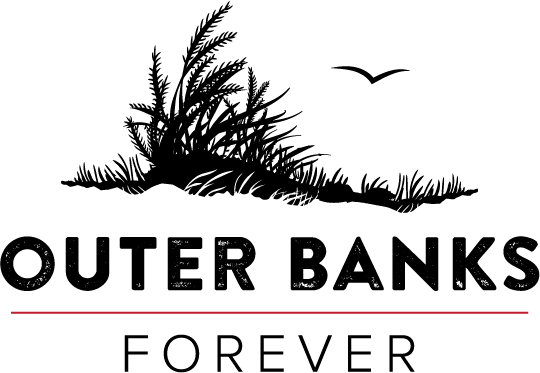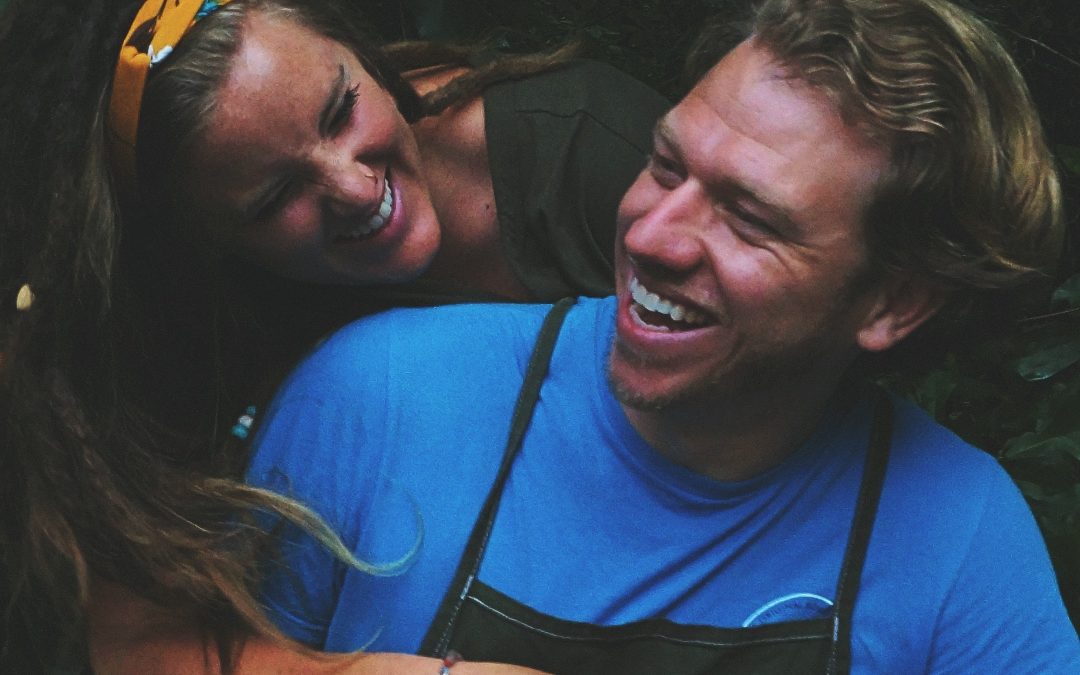June is National Ocean Month, and we’d like to introduce you to the Amabile family, the founders and artisans of Amabile Co., a family-owned and -operated company that supports organizations that are committed to protecting and cleaning waterways around North America through the sales of their handmade bracelets. We are grateful for their partnership and for their passion for Cape Hatteras National Seashore!
What was the inspiration for Amabile Co.?
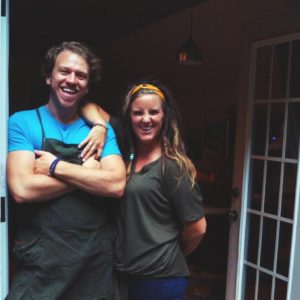
Adrian and Katie Amabile outside their home studio in South Carolina. Photo: Amabile Co.
Adrian: I think the why came to us before the actual idea of Amabile Co. We have always had a passion for the water. Katie grew up spending time with her family at this little lake house on Lake Wateree in South Carolina; she grew up basically on the water. I grew up all over the Carolinas. My childhood was in Wilmington, North Carolina, on the coast. Then we moved to the Asheville area, a little bit further north. I spent a lot of time on the rivers fly fishing, hiking, stuff like that. We later moved to South Carolina, where Katie and I met, and where we live now.
We’re a kind of a hippie family. We try limit our use of single use plastics. We have three different recycling containers – the kids get into it. We feel like it’s our responsibility to take care of what we have, to take care of creation, because it’s not just ours – we’re handing it down to our children.
So, the whole why behind Amabile Co. We always go to the Outer Banks every year for about a week or so with my parents. That’s a tradition that I remember from growing up; me and my dad would go there and we’d fish. As Katie and I had kids, it turned into a family trip. Now we have two trips: We go there with the family, and we go there to fish.
But this one particular year, I started working a job that pulled me away from the family a lot. I had always wanted to do my own thing, and I had my own studio space. I just never really had a why behind why I was creating something. It was always just like, “Yeah, I just need to do something different to get away from work and be able to do my own thing and spend more time with the family.”
Then we went on this trip to the Outer Banks right after Hurricane Florence in 2018. We got there the day they opened the islands back up to visitors. Growing up in Wilmington, I had seen the coast right after a hurricane; I had seen that devastation. It didn’t surprise me, but Katie and our two kids had never seen that. It was a huge shock to them.
And then, you know, little kids ask all kinds of questions. They were asking, “Where’s this trash coming from? Why is it out here?” Having to answer those questions for little ones was eye opening.
That trip got us thinking – I have a studio where I can make some jewelry products. How can we use this to help the situation? How can we take this why – because we want to do something better for our waters – and turn it into a product? I had been in the jewelry industry for about 10 years at that point, and I knew I wanted to do a simple, jewelry-style something. It took two years to gather the materials that we wanted to use because we knew that at every part of the process, we wanted to use sustainable and responsible materials that would really speak to our mission of cleaning the waters and building something that’s better for our planet.
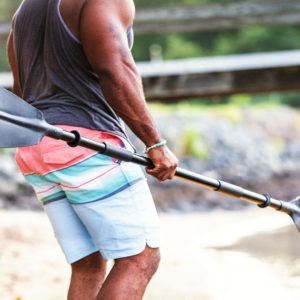
A friend of the Amabile Family models a “Hobcaw” bracelet. Photo: Amabile Co.
Katie: What gave us that idea is that there are other companies that do global-style cleanups, which is great. We need those to happen, too. But there really wasn’t anything that was locally based. People are more likely to get involved in something if it’s in the neighborhood where they live or in the areas where they vacation. When people have a tie somewhere, they’re more likely to want to get involved. We want people to get connected to their own personal community and not just a worldwide “out of sight, out of mind” type of deal.
When did Amabile Co. officially launch?
Katie: About midway through 2020. When the COVID-19 pandemic hit, Adrian was working at a jewelry store, and obviously they were considered non-essential employees. He was sent home for six weeks, and he had time to sit down and start planning and figuring out the details of Amabile Co. When he eventually went back to work, he was able to put in his two weeks’ notice and focus on Amabile Co. full-time.
How do you create your bracelets?
Adrian: We have several different styles of bracelets. The rope bracelets are my favorite; the simple ones with just an Amabile Co. charm on them – they are adjustable and slide on and off. I came up with that design because our first child is our daughter, and when her hair started to grow out, I would always wear a hairbow on my wrist for her hair. I looked down at my wrist one day, and I saw it and I thought, that’s cool. It made me smile because it reminded me of her.
As far as the materials, they are all recycled nylon and recycled sterling silver. And as far as the colors go, we just pick the colors that we enjoy looking at and then we name them based on the bodies of water our partners support.
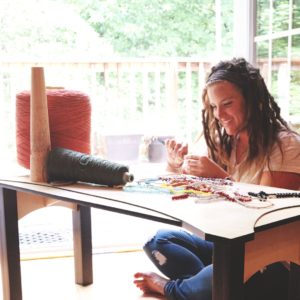
Katie Amabile strings beads on a bracelet. Photo: Amabile Co.
The recycled-glass bead bracelets we make involve a much longer process. I always wanted to create a bead-style bracelet, so I came up with those based on some other bracelets I had seen and then I modified how the endcaps work and how they tie together and how they wear, so they were as strong and durable as I could make them. We get our beads from a company that supports artisans in Ghana. I cast the silver parts of the bracelet, and Katie strings the beads and ties a knot between each one so they have a little bit more protection.
Katie: Those beads are fun too because they’re handmade by artisans in Ghana. Every time we order the beads, they are just a smidge different depending on who in the community made that set of beads. They might not have used exact amounts of pigments, so there might be pigment changes in the beads. Sometimes the beads are shinier; sometimes the beads look more like sea glass. It’s neat to see the differences in the appearance of the beads.
Where are your partners located?
Katie: They’re all over the place. They’re up in Maryland, Maine, all the way out in Nevada, California, Florida. Our goal is to, in a year or so, have a partner in at least every state, so that way everybody in the United States has an opportunity to be able to support some body of water that’s close by them. We have 24 partners in 15 states right now.
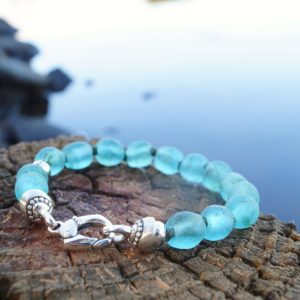
The “James” design bracelet. Photo: Amabile Co.
Why is Cape Hatteras National Seashore important to you?
Adrian: Like I said, I grew up on the coast, and I love the coastal lifestyle – that small town, community feel, like where you know everybody knows each other. How couldn’t you fall in love with it? You’re on this beautiful beach that feels untouched by anything else. It’s just so surreal, the landscape of the Outer Banks and Cape Hatteras. And people always seem so friendly and inviting.
Katie: Cape Hatteras is one of the first beaches we ever took our children to. They enjoy playing in the sand and getting in the ocean. Hearing them laugh at the waves – just having those sweet family memories. There’re a lot of firsts for our kids in the Outer Banks; that’s a main reason, at least for me, as to why I feel so connected. When we’re there, we really feel like we’re home, even though neither of us has ever lived there.
What is a favorite memory you have from your time at Cape Hatteras National Seashore?
Katie: It was October, one of the fishing trips that Adrian and his dad had planned. Adrian’s mom and I and our daughter, who was around eight months old and our only child at that point, tagged along that week. I remember seeing our daughter’s chubby little legs, her tiny feet, in the sand. It was her first trip to the beach. Seeing her out there watching the waves roll in, how she would laugh when the wind would blow the seafoam – she thought that was the funniest thing, and she would cackle laugh. When I think about the strongest memory I have in the Outer Banks, it was that day.
Adrian: I have a short, funny memory. I think it was that same trip. We were on the beach fishing, and we hooked into a sting ray, and it was huge. We fought it – my dad and I would go back and forth – for probably 15 to 20 minutes. We got it over the sandbar, and it suctioned itself to the bottom of the trough, maybe 10 feet in the water. When we were pulling it with the fishing rod, we could kind of see its wingtips. It would not move. So, we stood there and went to one side and pulled on it and the other side and pulled on it. And I was like, well, I’m just going to pull, and hopefully when I pull and the waves come, it will push it up and we can get it in and get the hook out.
Katie: At this time, a crowd of people had gathered because it looked like he had hooked something huge.
Adrian: So, I’m pulling, and of course, I leaned into it. About that time, the line broke…
Katie: And he went flying! It looked like something had blown him straight off the shore. He landed on his back, and it knocked the breath out of him. It was hysterical!
Adrian: I knew it was funny. When I was on the ground, I was laughing.
Why did you choose to support Outer Banks Forever?
Katie: We came to the Outer Banks last fall to go to the Southern Fried Half Marathon, and it wound up getting too windy, so they canceled it. So, instead of doing that, we went around to the different stores and talked to them about what water cleaning organizations were around, and Outer Banks Forever came up a couple times s as a reputable group. 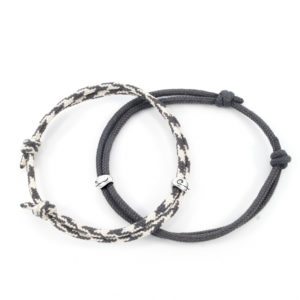 The “Outer Banks Pack” of Amabile Co. rope bracelets, featuring the “Frisco” and “Buxton” designs. Photo: Amabile Co.
The “Outer Banks Pack” of Amabile Co. rope bracelets, featuring the “Frisco” and “Buxton” designs. Photo: Amabile Co.
Adrian: One of the biggest things that drew me into it was that Outer Banks Forever is partnered with the National Park Service. Considering the majority of the Outer Banks is a national park, that was one of the coolest things for me. I really liked that concept: that Outer Banks Forever helps the national parks, and the national parks help Outer Banks Forever.
What do you want people to understand about Amabile Co. and protecting waters?
Adrian: I don’t feel like we make huge sacrifices in our day-to-day lives to get rid of things like single-use plastics and to make more sustainable and responsible decisions. It doesn’t feel like it’s that hard for us. And we have three kids – there are a lot of single-use products out there that are wasteful that we decide not to use, but I don’t feel like it’s a hard decision. Seeing our kids grow up, and the older they get, and the decisions they make, and how their thought process works and how some of their choices are based on what is a more responsible decision. Obviously, they don’t use the word “responsible,” but they’ll say things like, “I don’t need to waste a plastic bottle; I have a cup of water at home.” Just knowing that all those little decisions we make do make a big impact. They’re forming the way our little ones think on a daily basis.
With that in mind, as a company, we’re trying to be a brand that people will feel good about supporting and that will encourage people to make those little choices, because those little choices are the ones that add up and really make a big impact.
Katie: I think the biggest thing we want people to get out of our company is to be connected to their community and to their local water sources and know that it doesn’t take drastic changes to make a difference. When people make small changes, big things can happen. It takes a lot of people making small choices to make a difference.
How can people get involved with your mission?
Katie: Even if somebody just purchases a bracelet, that’s going to help them get involved in cleaning waters in their communities, since 10% of that purchase is going to go back to whatever organization they choose. The other part of what we want to do is stay connected to those local communities and local water sources, and we want people to know what those organizations do, whether it’s beach cleanups or helping to spread the word of big plans—like fighting for legislation – or picking up trash.
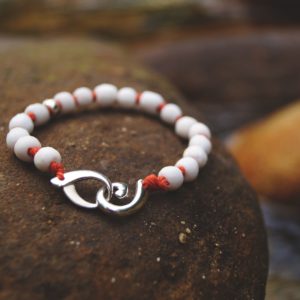
The “Gowens” design bracelet. Photo: Amabile Co.
Adrian: You can also share our mission on Instagram and Facebook and tell your friends about us!
Is there anything else you would like to share with us?
Adrian: I think a lot of times people look at our website and think we’re a bigger company than we really are. It’s just our family – just the two of us, and the kids help out sometimes, you know…de-organizing things. We are a small family business, and we try our best to make every decision that goes into our business with our mission in mind.
Katie: We sit at our dining room table and string bracelets and hand snacks out!
To learn more about the Amabile family and Amabile Co., please visit: www.AmabileCo.com and follow them on Facebook and Instagram!
If you would like 10% of your purchase from Amabile Co. to support Outer Banks Forever, select “NC – OuterBanksForever” from the “Water Protecting Partners” dropdown menu at checkout.
